As my previous uniform post had such a great reception (Victorian Stable Jacket – 3rd Dragoon Guards), I thought it time I do another!

Since my last post, I’ve discovered another Victorian tunic, this time to the Royal Marine Light Infantry (RMLI). Although named and dated, the tunic has proved much harder to research than I first anticipated! As it may prove beneficial to others, I have documented my research journey below.


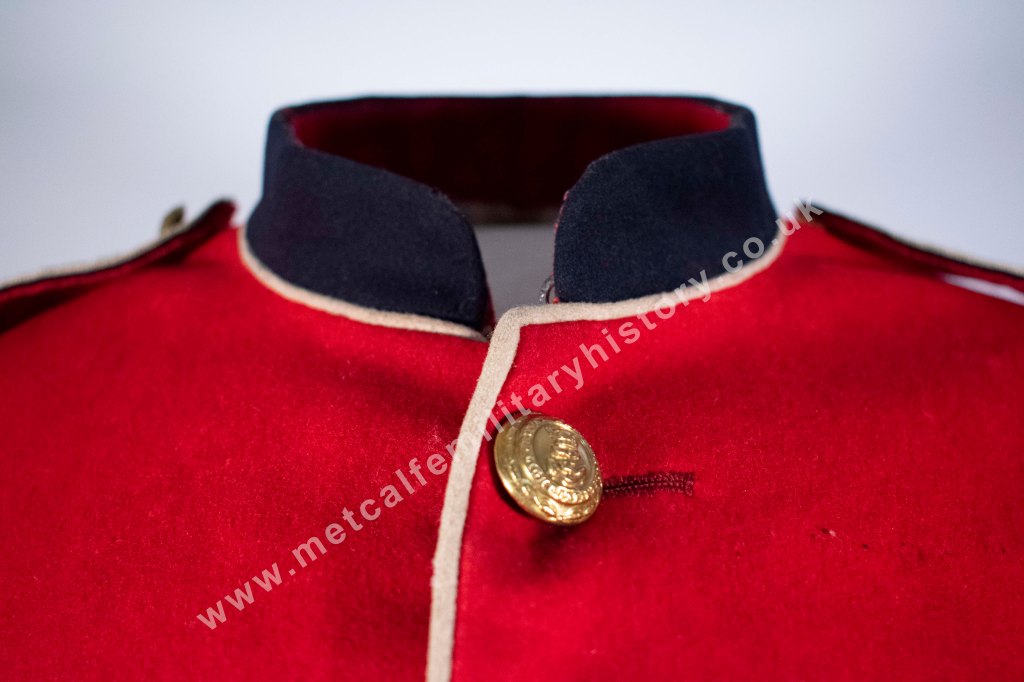
This particular tunic pattern was worn by the Royal Marine Light Infantry between roughly 1874 and 1904 (For the Post 1903 Tunic, see “Royal Marine Light Infantry Tunic – Post 1903“). The tunic is stamped with 30.4.83, making the date of issue the 30th April 1883. Directly underneath is stamped the owners details 28?.T.DOWNING. The name is also stamped several times in the lining, although these have now faded significantly. Additionally, it has an inspection stamp dated January 1883.
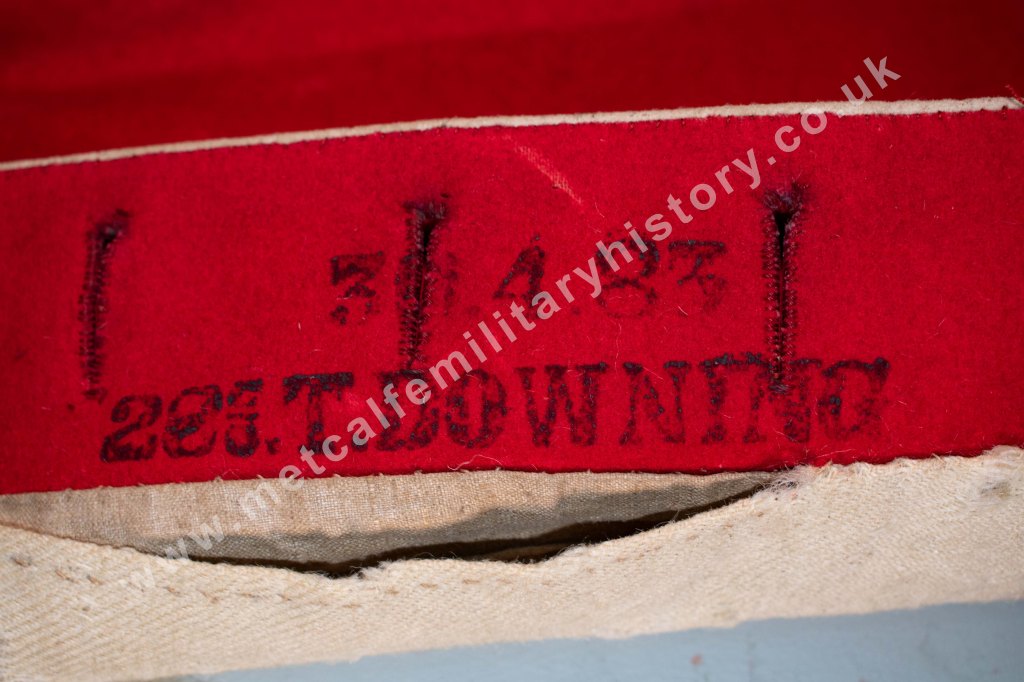
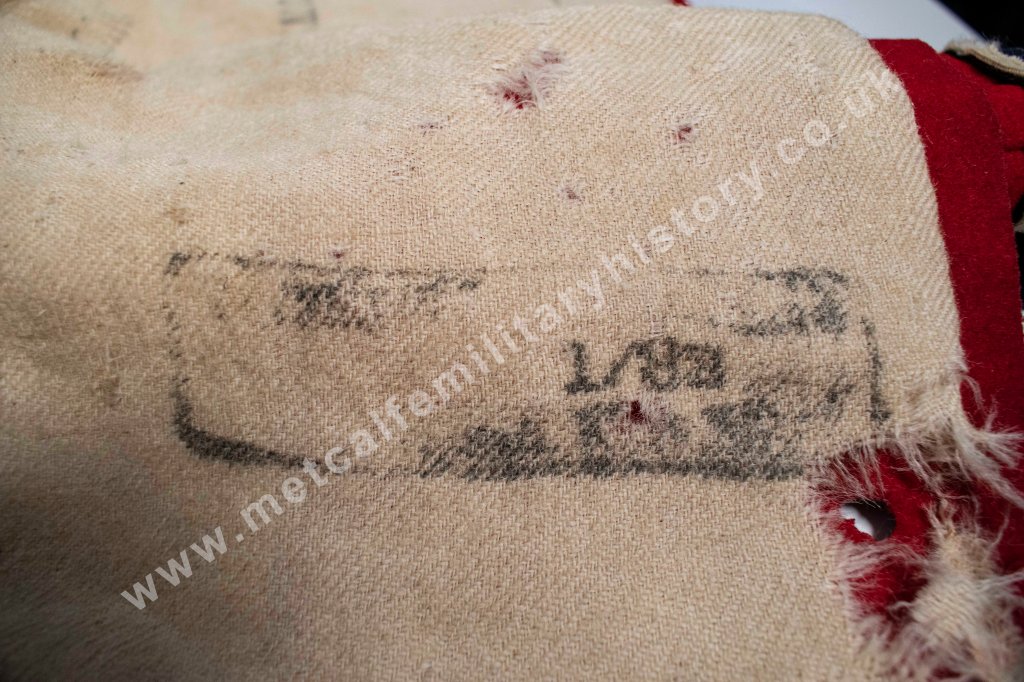
As Royal Marine service records for this period are held by the National Archives (and downloadable online), in theory it should have taken minutes to find the Marine who was issued this tunic. Having spent a considerable time looking online (Available through The National Archives), I could not find an exact match for the name and number stamped in the tunic.
Being stubbornly determined when it comes to this sort of research, I was not willing to give up so easily. So what next?
As the name DOWNING is also stamped elsewhere in the tunic, I was fairly confident that the name was correct. The tunic is also correct for the date of issue stamped inside, and I’m confident that the stamping is all as it should be. I now wanted to find all the Downings who could have been serving with the RMLI during 1883, which would give me a list to start with.
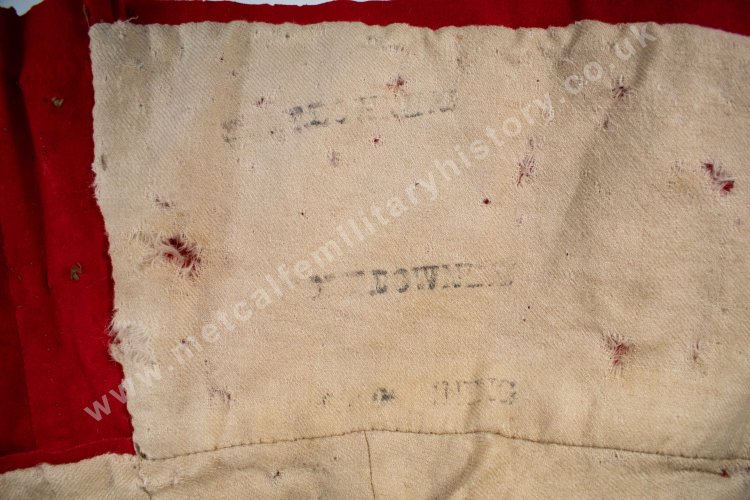
Having used the search facility on The National Archives website, I found a total of 5.
41 RICHARD W DOWNING – Enlisted 28th July 1864
480 CHARLES DOWNING – Enlisted 27th August 1869
454 WALTER DOWNING – Enlisted 16th October 1871
1476 ROBERT THOMAS DOWNING – Enlisted 6th November 1878
1964 RICHARD DOWNING – Enlisted 1st December 1880
The next step was to go through the list and eliminate any of the men who it couldn’t have belonged to. Luckily, The National Archives are currently (late 2020) allowing these records to be downloaded for free, due to on-site restrictions due to COVID-19. Otherwise, each record would usually cost £3.50 to download.
41 Richard W Downing had been promoted Sergeant School Master just two days after enlistment in 1864. He was still in this position in April 1884, making this the wrong type of tunic for him. We can therefore remove Richard from our list.
480 Charles Downing had already been awarded three good conduct badges by April 1883. He was subsequently awarded a fourth in August 1885 (and later a fifth). The tunic we are researching has one period good conduct badge sewn on, making it unlikely to have belonged to Charles. In addition, his initial and number bear no resemblance to those stamped on the tunic. I’m therefore confident I can remove Charles from our list.

454 Walter Downing had already been awarded two good conduct badge by April 1883. He was subsequently awarded a third in October 1883 (and later a fourth). It is therefore very unlikely the tunic belonged to Walter for the same reason as Charles above. In addition, his initial and number also bear no resemblance to those stamped on the tunic. I’m therefore confident I can remove Walter from our list.
All three of these men enlisted in the RMLI earlier than I would have expected for the owner of the tunic. I am now left with only two men the tunic could have belonged to.
41 RICHARD W DOWNING – Enlisted 28th July 1864
480 CHARLES DOWNING – Enlisted 27th August 1869
454 WALTER DOWNING – Enlisted 16th October 1871
1476 ROBERT THOMAS DOWNING – Enlisted 6th November 1878
1964 RICHARD DOWNING – Enlisted 1st December 1880
On investigating the service records of the two remaining men, I couldn’t really find anything that would immediately eliminate either from my search. Both men were serving with the RMLI and would’ve had one of these tunics. To determine which of these two men the tunic was issued to was now going to take some deduction, and an in-depth analysis of the tunic for additional clues.
The most obvious first clue is the name itself. As previously mentioned, the tunic is named to 28?.T.DOWNING. Now I don’t think the stamp after the 8 and before the T is R for Robert, but he is the only one with an initial T.
I could see from the records that only Robert had been awarded medals for his service. As these medals would have been awarded just before the issue of the tunic, I took a closer look for any evidence of medals having been worn. Closer inspection revealed that medals had indeed been sewn on at some stage, and the medals themselves had actually left a very faint imprint/mark.
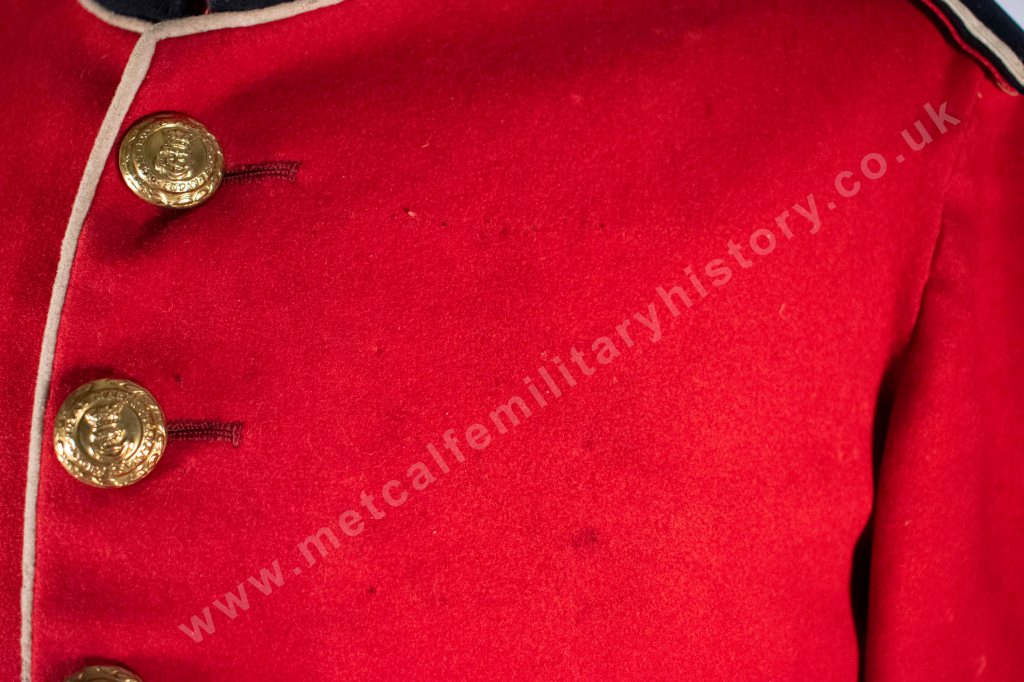
By this point, I am leaning heavily towards the tunic having belonged to Robert Thomas Downing, who had indeed been awarded the Egypt Medal and Khedive’s Star. Although my research to this point revealed it could have only belonged to him, I still wanted to really verify the connection.
What had bothered me from the start was the number 28?. I could find no Downing with a number being with 28. Scanning though the service records and medal rolls for Robert Thomas Downing, I had noticed he was serving with 28 Company, at the time this tunic was issued. Now I have never come across a tunic marked with the Company number rather than service number, but I suppose it is possible and certainly fits in with everything else. With this in mind, the ? after 28 could in fact be C over O, indicating company. Further research has revealed that Royal Marines were not identified by allocated numbers until 1st July 1885. Before this, men were identified by their company number and surname (I shall certainly remember this for the future!). This confirms that this tunic was therefore issued to Downing of 28 Company, RMLI.
I had now confirmed beyond doubt that this is in fact the tunic of 1476 Pte Robert Thomas Downing, 28 Company, Royal Marine Light Infantry.
1476 Pte Robert Thomas Downing
Robert Thomas Downing was born on 8th February 1855 in Adwick le Street, Doncaster. He was baptised on the 17th June 1855. Little is known of his life before he joined the Royal Marines, although we do know he had been working as a labourer.
Enlisting into the Royal Marine Light Infantry on 6th November 1878 at Doncaster, Robert arrived at the Recruit Depot two days later. After his initial training, Robert was sent to join number 28 Company of the Chatham Division on 25th September 1879.
Robert was promoted to Corporal on the 20th January 1881. I have been able to find very little on his service with the RMLI thus far, but this changed on the 26th July 1882 when he embarks for the Sudan onboard HMS Northumberland.
Sudan
Cpl Downing was one of 150 men from the Chatham Division, who were to form a second RMLI battalion for active service in Egypt. In addition to the 150 men from Chatham, the battalion consisted of a further 150 men from Portsmouth Division and 100 men from Plymouth Division (with an addition 100 men of the Royal Marine Artillery from Eastney) under the command of Lt Col Jones.*
The battalion arrived in Egypt on the 20th August 1882 and were to take part in the battle of Tel-el-Kebir on the 13th September 1882.
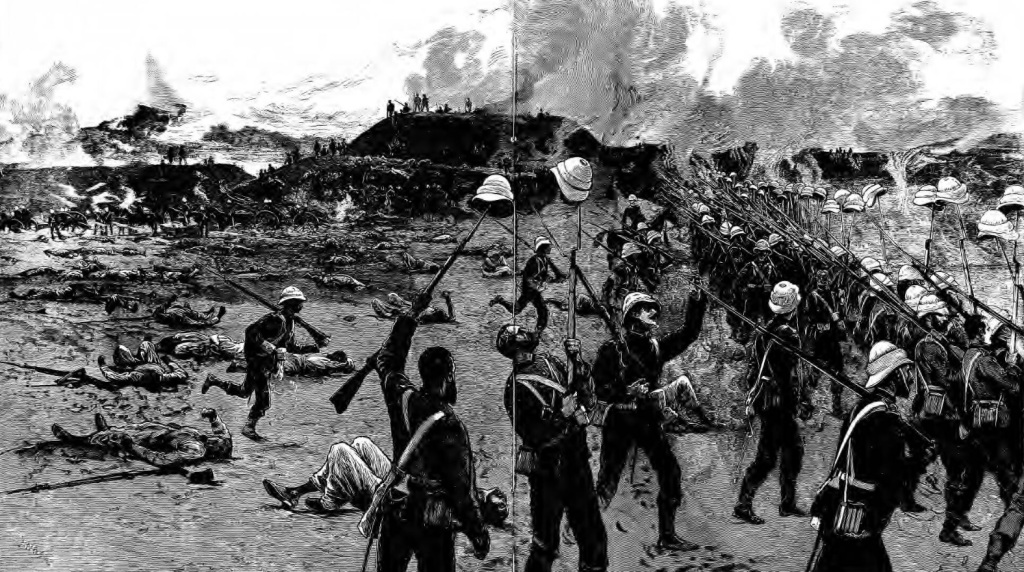
After the battle, it wasn’t long until the Royal Marine battalion were to return to the UK, after a short, yet arduous campaign. They returned home to a heroes welcome in October 1882, with a banquet being held for the men at Chatham, which was wonderfully illustrated in The Graphic.

The celebrations didn’t end here, as in November 1882 a royal review took place in London of those troops who had returned from Egypt.

*When lockdown ends and archives reopen, I am hoping to explore the role of the second Royal Marine battalion in the Sudan. Watch this space!
1883
According to his service record, Robert returned to the UK on the 24th October 1882. It was not long after this that he was issued with the tunic we have been investigating. For reasons unknown, Robert was confined to barracks for 8 days on the 14th October 1883, and on the 15th October 1883, reduced to the rank of Private.
Prison
This wasn’t the end of his troubles, and on 26th March 1884, Robert was sent to prison. Unfortunately, I have been unable to find out why, or if it was related to his earlier demotion and confinement. It is unlikely that the offensive committed was serious, as Pte Downing only spent 20 days behind bars.
HMS Dolphin
Within a month of being released from prison, Robert now found himself posted to HMS Dolphin, a new sloop under the command of Commander Eardley-Wilmot and destine for the Mediterranean.
It was whilst serving onboard HMS Dolphin that Robert would return to the Sudan, this time at Suakin. Although HMS Dolphin did send sailors ashore to man guns, it is unclear whether Robert served ashore or solely onboard during this time.

For his service onboard the Dolphin, Robert was entitled to a share in slave captures made by the ship, which would appear to have certainly been around Egypt, and most likely around Suakin.
Robert remained with HMS Dolphin until the 30th September 1887.
HMS Thalia
On the 31st September 1887 Robert transferred to HMS Thalia. His stay onboard was to be brief, as he was paid off on passage on the 24th October 1887, returning to the Chatham Division. On the 21st November 1887, Robert married Fanny Carr at Wadworth. They would go on to have two daughters together.
Robert was discharged from the Royal Marines on the 7th February 1888. For his services, he had been awarded the Egypt Medal with clasps for Tel-El-Kebir and Suakin 1885, as well as the Khedive’s Star.
Later Life
On leaving the Marines he went to live at Westwoodside, Haxey, Lincolnshire. He began work as a carter but quickly made a life for himself outside of the Marines.
By 1901 he was running his own grocers and working as a shopkeeper in Wadworth. Ten years on, Robert was working his own farm and was living with his family in Wadworth.
Robert died on the 18th February 1924 at his home, Sunnyside Farm, Wadworth. A photograph of his grave can be found online here. As Sunnyside Farm in on Carr Lane, it’s possible the farm was inherited from his wife Fanny’s (née Carr) family.
Very interesting read. I have an ancestor who was a marine on board HMS wild Swan , serving in the Royal navies block aid of slavery of the coast of Mozambique he enlisted on the 31/01/1874 , Born 31/01/1840 . Matthew Knowles his the service number I believe is 685 he served for 20 + years
LikeLike